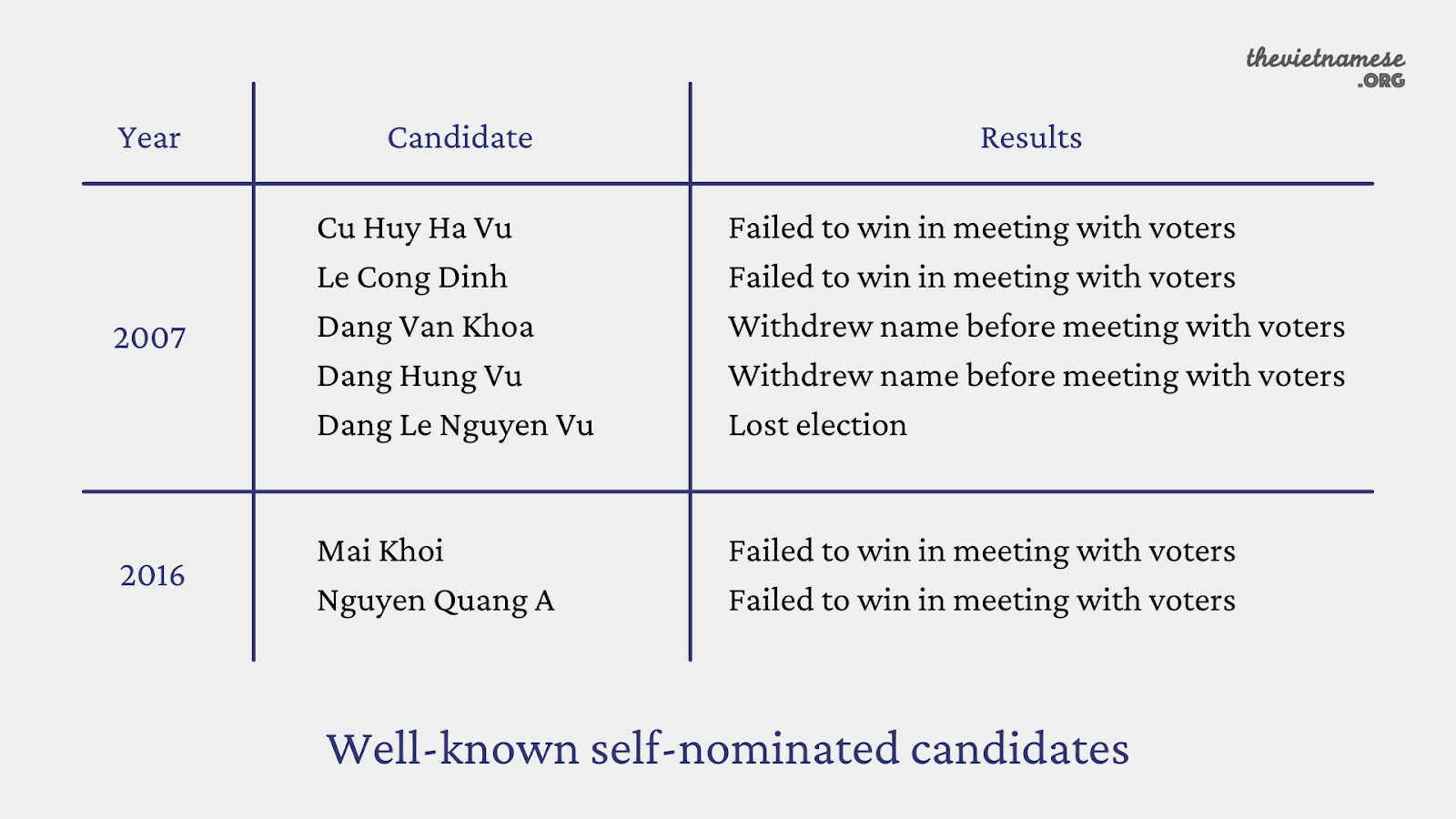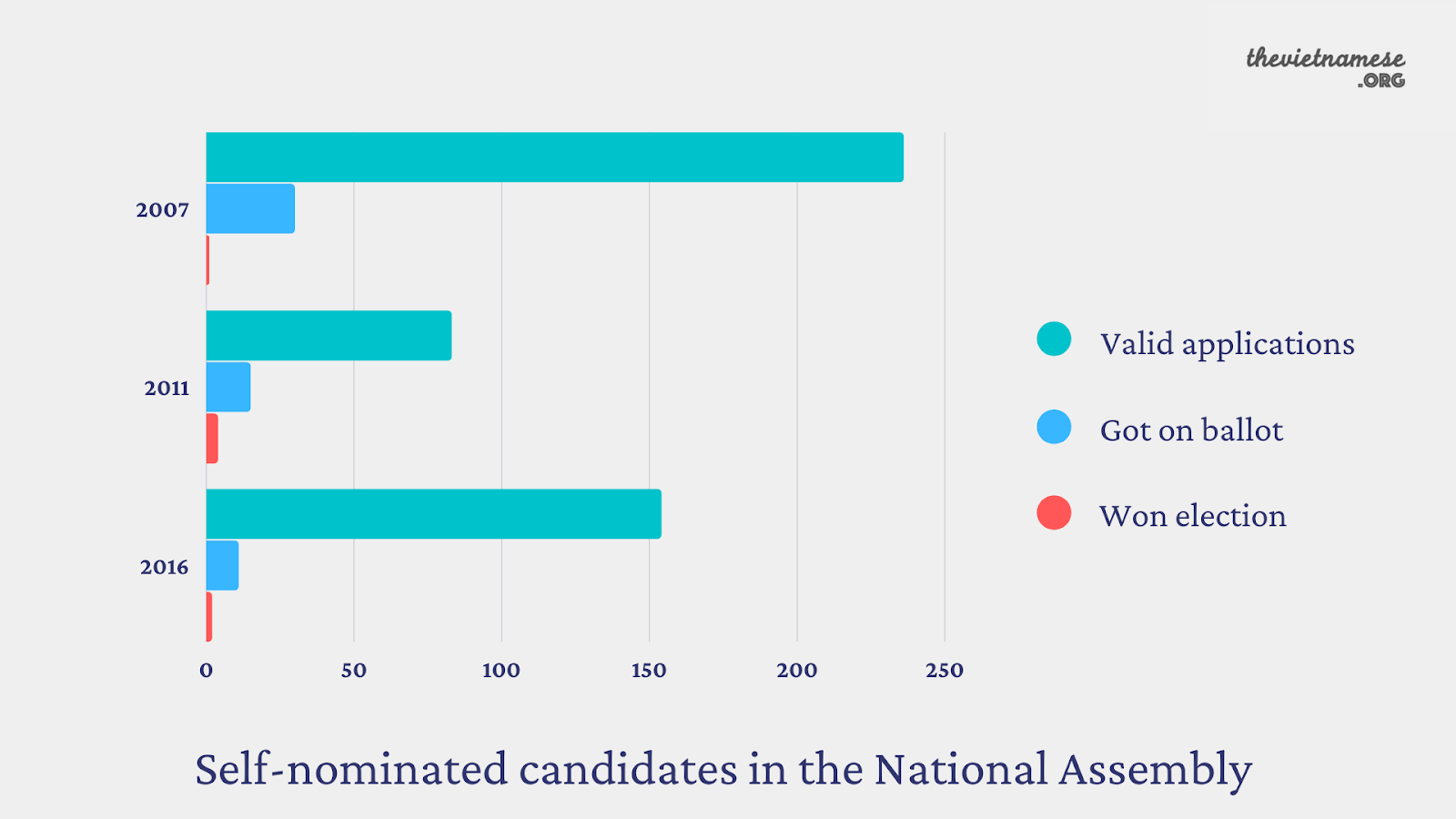Breaking Free from the “Procrustean Bed” of History
Thanh Tâm wrote this article in Vietnamese and published it in Luat Khoa Magazine on May 7, 2025. Đàm Vĩnh

Vietnam has been consistently categorized as “not free” and “authoritarian” by many organizations, such as Freedom House and The Economist. The Economist went so far as to rank Vietnam at the bottom of its Democracy Index in Asia – only ahead of Afghanistan, China, Laos, and North Korea. Annual human rights reports of various human rights organizations, such as The 88 Project, also document the government’s continuous blatant and brutal suppression of political dissent.
One of the most prominent reasons attributed to the country’s abuse of power and authoritarianism? Undemocratic elections.
Authoritarian regimes around the world often conduct elections to appear more legitimate and democratic. Elections in authoritarian countries such as Russia, China, or Cambodia are often performative, as they mostly result in the same people or party holding on to power. Similarly, Vietnam also has elections, but it is hard to call the elections democratic given its methodology and context as a one-party state – which only recognizes the Vietnamese Communist Party (VCP).
But how do elections work in Vietnam? Are there non-Party candidates and how do they get nominated? Is the election effective in forming political competition and avoiding the VCP’s monopoly on power? As the 2021 National Assembly election approaches, this article answers these questions using Professor Paul Schuler’s scholarly writing on Vietnamese politics.
Paul Schuler, assistant professor at the University of Arizona, is a scholar studying authoritarian regimes in East and Southeast Asia, with a particular focus on contemporary Vietnamese politics. His book, “United Front: Projecting Solidarity through Deliberation in Vietnam’s Single-Party Legislature,” was published earlier this year by Stanford University Press. This article is based on Chapter Two, “How Elections Work in Vietnam.”
The electoral system in Vietnam is a bloc voting system, in which each district is distributed two or three seats in the National Assembly. Each voter can vote for as many candidates as he or she wishes, as long as they do not exceed the number of seats available for their district.
The National Election Council and provincial boards are tasked with overseeing details of the elections, such as the number of candidates and the candidates who appear on the ballot. The Council determines the number per province, while the provincial boards determine the number per district. However, this premature election process is ripe for manipulation.
Up until 2015, there were no regulations regarding the competitiveness of district elections, meaning there were no laws surrounding the number of candidates competing for a seat. As a result, there were cases of districts with three slots, but only four candidates competing. The 2015 Election Law regulates that the number of candidates per district must be at least two more than the number of seats up for grabs. For example, if a district has two seats available, there have to be four candidates at the minimum.
The Vietnam National Assembly Standing Committee (VNASC), a combination of those leading the National Assembly, such as the chairperson and his/her deputies, also greatly influences this process. The law allows VNASC to rewrite or amend election law as it sees fit. In fact, Vietnam’s election law has been changed before every election. This gives the VNASC the power to potentially manipulate the election right before it even begins.
If Vietnam is a one-party state that only recognizes the VCP, could people run for elections without being a member of the VCP? If they can, does that mean there is effective political opposition to the VCP?
The short answer to the first question is yes. And indeed, the VCP has been using this fact as proof of democratic credibility, claiming anyone could become a delegate. But the story is much more complicated than that because the answer to the second question is no.
There are two types of candidates that, theoretically, would introduce political diversity: non-party members and self-nominated candidates. While the two categories often overlap (independent candidates who self-nominated such as activist Nguyen Thuy Hanh), they are not the same. The case of Duong Trung Quoc is an example. He was a non-party candidate, but he was nominated by the Vietnam Historians Association, an organization related to the Fatherland Front (an umbrella group of organizations aligned with the VCP).
Here is where the story gets complicated. There is no guarantee that all non-party members and self-nominees will be able to present meaningful challenges to the VCP. This is because there are non-party members who get nominated by organizations related to the Fatherland Front, such as Duong Trung Quoc. There are also VCP members who nominate themselves. Candidates falling under these categories are still counted as non-party and self-nominated members, despite links to the VCP.
Even if we assume that all non-party members will be able to effectively compete with the VCP, the VCP still retains a great degree of monopoly on power. The percentage of non-party delegates has never exceeded 15 percent. In 2016, despite the surge of independent candidates, the percentage of non-party members in the legislature dropped to 5 percent – the lowest percentage since 1976. And the number of self-nominees is always very small.
Why is the number of non-party and self-nominated candidates so compromised? This is because of the design of the vetting process.
There are five “gates” in the process of narrowing down the number of candidates. These steps, however, allow possibilities for the VNASC to determine election results as it sees fit – perhaps even before the election starts.
Participating in the elections, there are two modes of nominations: central nominees and local/provincial nominees. Those nominated by the central government are more influenced by the VCP, and hence, enjoy a more favorable procedure.
Gate 1: Quota determination for the next National Assembly
This is the initial stage of the election in which the VNASC determines the demographic quota for the next National Assembly – the desired structure of the subsequent National Assembly.
In 2007, for example, the National Assembly was to include “150 women, 50 non-party members, 70 delegates under forty years old, and 160 incumbents,” according to Paul Schuler. The determination goes as far as imposing quotas on “how many members of the Fatherland Front, the government, and the local party apparatus should be selected.” During this step, the VNASC tasks the provinces with choosing certain provincial candidates to fulfill the quota.
Hence, this predetermined structure of the National Assembly is criticized for hurting self-nominated candidates, who were not considered for when the VNASC drew up the quota. How do the self-nominees – who might not satisfy the determined structure – fit in?
Gate 2: Candidate introduction
This is the step in which people submit their self-nomination, followed by an announcement of self-nominees who have successfully completed their applications. In this announcement, candidates nominated by the province in step 1 are called “introduced” (được giới thiệu) candidates, distinguishing from “self-nominated” candidates (tự ứng cử).
Gates 3 and 4: Meeting constituent and the candidates’ co-workers
This is the step that is considered the “red line” for self-nominated candidates, as it disqualifies many unfavored candidates from competition due to manipulation of the process as well as the underhanded persuasion of public opinion.
After the introduction of nominees, two meetings are held between the candidates and the local constituents to assess and vote on the candidates. While both types of nominees are required to meet with the voters in their neighborhood, central nominees simply meet with their co-workers in one of the meetings – increasing their chance of passing the round.
The odds are also stacked against self-nominated candidates as the Party has the power to determine who could present at the meetings, as well as exerting pressure on others not to vote for their unfavored candidate. Indeed, Schuler’s research shows that people with an affiliation to the VCP are 14-22 percent more likely to be chosen for these meetings than those without an affiliation with the VCP. Local officials also conduct door-to-door campaigns to discredit self-nominated candidates if they are not favored by the VCP.
In other words, the meetings which were supposed to represent the constituent’s democratic will, are actually just occasions and excuses to exclude unfavored candidates.

Gate 5: The final ballot
At this stage, reports from the vetting rounds are submitted to the National Election Council, which determines the final list of candidates appearing on the ballot in each province. The list is then sent to the provinces to produce the final ballot.
Over the years, the number of self-nominated candidates who have gotten on the ballot and won the election has been alarmingly low. Those who got their names on the ballot account for just around 6 to 11 percent of the valid applications. Only less than 1 percent of valid self-nominated candidates eventually were elected (see illustration below).

(More information about the vetting process and election milestones can be found here.)
Yes. As explained above, the VNASC has many ways to interfere in the election, perhaps even before the election itself starts. The vetting process, while being presented to ensure the candidates’ qualifications, actually is a way for the VCP to identify dissidents and eliminate them from the competition, paving the way for favorable and conforming candidates.
Other than manipulating the election to eliminate dissidents, the VCP also manipulates it to safeguard the victory of the people it wants to win. Additionally, for the VCP high-ranking “star” candidates, the election is also a chance for them to fabricate that these officials have the overwhelming support of the people.
There are several ways this can be done. For example, “sacrificial lambs” could be introduced into the election as candidates. Then, they are placed into competition with the high-ranking candidate, as the provincial authority could decide on the candidates’ placement into different voting blocs. As these “sacrificial lambs” are supposed to lose, the star candidate with name recognition easily wins with overwhelming support.
This is evident in the 2021 election. Nguyen Phu Trong, the secretary-general of the VCP, and one of the most important figures in the government is placed into competition with a vice-principal of a high school, the head of a Hanoi local government agency specializing in architecture, a researcher in rural development, and a commander of local forces in Hanoi.
Another way to ensure the star candidate wins is simply to avoid the placement of star candidates into the same race. This is easily arranged, considering the fact that the provincial authorities have the power to arrange bloc placements.
This piece has presented the many ways in which the electoral process in Vietnam is manipulated to the benefit and desires of the VCP. However, there are still rules not mentioned above that restrict the ability of the candidates to campaign and the people’s ability to choose.
There are some rules about campaigning that are debatably beneficial, such as forbidding candidates to raise funds or use personal wealth to run for office to prevent the monopoly of the rich in politics. However, there are various other restrictions that mostly aim to retain the power of the VCP. For example, candidates are not allowed to organize campaign rallies, and they can only campaign through the state-controlled mass media. They may also meet their voters, but only through meetings organized by the Fatherland Front.
Even with all of the restrictions, voters only have around a month to get to know the candidates before voting.
At this point in the article, perhaps you have already formed an opinion or two about whether the system is democratic or not.
Vietnam's independent news and analyses, right in your inbox.